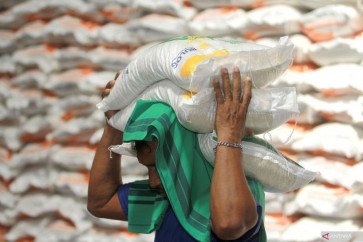Popular Reads
Top Results
Can't find what you're looking for?
View all search resultsPopular Reads
Top Results
Can't find what you're looking for?
View all search resultsAnalysis: Indonesia cement: Still no notable pickup
Based on data announced by the Indonesian Cement Association, the countryâs domestic cement industry experienced a slow month in February as cement volumes reached 4
Change text size
Gift Premium Articles
to Anyone
Based on data announced by the Indonesian Cement Association, the country's domestic cement industry experienced a slow month in February as cement volumes reached 4.5 million tons, a 2.5 percent decline month-on-month (m-o-m), and a 2.9 percent increase year-on-year (y-o-y).
On the back of weak January volumes, this brought January-February volumes to a total of 9.2 million tons, representing growth of only 1.3 percent y-o-y compared to the same period in 2013. Apart from the higher interest rate environment, we view unfavorable weather conditions as a main reason behind the weak performance.
Continued weak performance is in line with our view that the industry will face challenges from the demand side as we currently expect 2014 growth of 5.2 percent y-o-y, much lower compared to 2012's growth level of 14.5 percent y-o-y and even 2013's level of 5.6 percent y-o-y. Our expectation is also in line with our economist's view on the country's gross domestic product (GDP) slowdown to 5.3 percent in 2014 from 5.7 percent in 2013.
With a higher base interest rate at the start of 2014 compared to last year, the sector is also negatively impacted by Bank Indonesia's (BI) new mortgage regulations issued in October 2013. This is because nearly 80 percent of domestic cement is sold by the bag rather than in bulk, a testament to Indonesia's volume growth, which is driven mainly by housing-related projects rather than infrastructure.
Margins for cement counters will also be adversely impacted by the impending electricity rate hike. The government and House of Representatives decision to revoke subsidized electricity from PLN, Indonesia's state-owned electric company, for industries starting May 1 will add pressure, as electricity accounts for around 12-20 percent of a cement company's production costs.
A potential 30 million tons of additional capacity coming from existing and new cement players over the next three years could see the utilization rate drop from 92 percent in 2012 to around 70 percent by 2016 should demand remain weak. This will likely affect cement companies' ability to increase sale prices.
Recently, Indonesia's largest cement producer, Semen Indonesia, announced its target to increase average cement prices by 2-3 percent throughout 2014, which is much lower compared to the previous two years in which cement prices increased beyond the 5 percent level.
However, a ray of light could potentially emerge at the end of the dark tunnel if macroeconomic conditions can continue to improve in the months to come.
On a more positive note, the Indonesian rupiah has appreciated 7 percent to 11,300 per US dollar in a space of under 3 months, way ahead of our economist's hope it would reach a similar level by the end of 2014. Should the currency keep on strengthening going forward, this should help to relieve pressure on the cement players' margins as around 50 percent of their costs are in US dollars.
In conclusion, however, we think the risk-reward trade off continues to remain negative for equity investing at this stage of the cycle, and we remain lukewarm on the cement sector.
The writers are analysts at PT Bahana Securities










